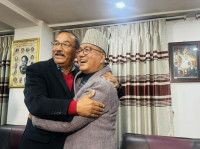Politics
With little representation in top leadership, former Maoist leaders fear being swallowed by the former UML
Former UML leaders hold a majority in most leadership bodies, leading the former Maoists to worry that their identity is being subsumed by their former rivals.
Tika R Pradhan
On Friday, in a display of discontent, irate leaders of the former Young Communist League took down the signboard of the National Youth Association Nepal and threw it away. The Young Communist League is the former Maoists’ youth wing while the National Youth Association Nepal will soon be the unified student association of the League and the former CPN-UML’s Youth Association Nepal, once all disputes are resolved.
YCL leaders said that they had only agreed to retaining the name and flag of the former UML’s youth wing on the condition that all central positions be shared equally between the two former parties. Former UML leaders had not lived up to their end of the bargain, according to the YCL.
“After they backtracked on the agreement, dialogue has been stalled,” said Subodh Sherpali, general secretary of the YCL. “Now we will have to review the agreement. We can’t accept the Youth Association’s name and their flag anymore.”
Friday’s display was just one instance of the long-simmering dissatisfaction within the Nepal Communist Party (NCP), which was formed last year after a merger between the country’s two largest communist forces. Former Maoist leaders are increasingly feeling cornered, both in government and in the party, with most important positions going to former UML leaders.
Maoist student leaders are unhappy with the party’s decision to select Ain Mahar, general secretary of the UML’s student wing, as coordinator of the unified student wing, while Ranjit Tamang, chairperson of the Maoist students’ wing, was made joint-coordinator, a step below Mahar. Tamang had expressed dissatisfaction, only accepting the role after party Co-chair Pushpa Kamal Dahal asked him to take the position for the sake of party unification. Subsequently, student leaders from the Maoist and Madhav Nepal factions had boycotted a meeting of the unified student union called by Mahar on July 19. “We had agreed to accept the joint coordinator only because co-chairman urged so that the unification process won’t be affected,” said Dipak Devkota, vice-chairman of the former Maoist student wing.
Within the larger party, discontent is brewing, with many leaders saying the ruling communist party looks more like a front than a unified party, as there is a clear division between the two factions in all party committees.
Leaderships of all party committees, departments and sister wings have gone largely to former UML leaders. Among the party’s 33 departments, including the Policy and Research Academy, top leaders had agreed to allocate 18 departments for the UML and 14 for the Maoists, but have yet to decide which faction would get the School Department.
But all major departments, including Finance, Organisation and Foreign, are under former UML leaders. Maoist leaders had thus asked for the School Department, another major department, but were denied.
“It seems that the Maoists will have nothing. It is as if the Maoists are gradually dissolving into the UML,” said Lekhnath Neupane, a central committee member. “Soon, there will be no traces of the Maoist party left.”
Maoist leaders would boast that their agendas were leading the country and they had only agreed to merge with the UML to have the numerical strength to ensure that the agendas were implemented. But given their current position within the party, they’re afraid that the UML’s agendas will now prevail.
“We had merged with the UML to ensure proper implementation of our agenda but now federalism has gone the way of decentralisation,” said Ram Karki, a Maoist leader and former minister.
The nine-member secretariat, the party’s highest executive body, has only three Maoist members—Pushpa Kamal Dahal, Ram Bahadur Thapa and Narayan Kaji Shrestha—while the 45-member standing committee has just 19 Maoists. The 147-member politburo, which will be formed soon, will have 66 Maoist members while 81 will be from UML.
The former Maoists’ identity itself is slowly getting subsumed by the UML. The directive principle of the Maoist Centre–Marxism, Leninism and Maoism—has been dropped in favour of the UML’s Marxism and Leninism. The unified party has also adopted the UML’s election symbol, the sun, which the Maoists had vehemently opposed.
A few senior Maoist leaders, however, blame their own leadership for these developments.
“It’s part of political culture to finish off rivals to gain power and the former UML has followed the same pattern,” said Mani Thapa, a standing committee member. “The problem is with the mindset of our top leaders who jumped into the merger just to gain power, without preparing for its consequences.”
The merger was a strategic move for the UML but for the Maoists, it was just a tactic, said Thapa.
A solution to this identity crisis would be for both UML and Maoist leaders to attempt to develop a new party, instead of trying to gobble the other up, said Yubaraj Chaulagain, a central committee member.
“UML leaders should become more radical while the Maoists should socialise themselves so that a new political culture will develop, one that can cater to the need of the hour,” said Chaulagain.
Thapa, a former Maoist leader, however, was more cynical about the future of the Maoists.
“The legacy of the Maoist party is almost finished,” he said.




 9.12°C Kathmandu
9.12°C Kathmandu















